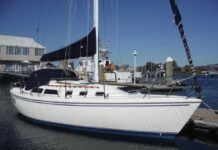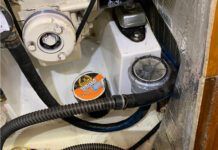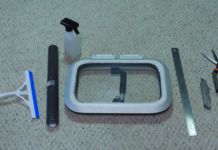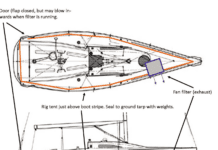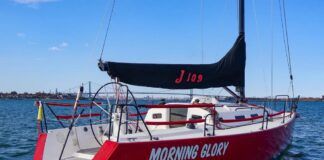I wonder how many people have given up sailing because of the effort it takes to tack a genoa shorthanded. Aside from hitting hard objects suddenly and scaring ourselves witless, or hitting them slowly and inexorably, as when trying to maneuver into a slip in a cross-current, and embarrassing ourselves into a dark and despondent state, I think this business of tacking a big cruising headsail when understaffed and uninspired by competition is the thing most likely to make people head for the fruited plain, never to return.
When you’re racing, the boat needs to go its fastest through the water, and to particular spots on the race course as quickly as possible. In that case there are people aboard whose overriding purpose and lusty intent is to move sails expeditiously.
Let’s say, though, that you’re cruising, and it’s just you and your spouse managing the genoa. Even assuming that you have roller-furling gear and self-tailing winches, someone still has to bestir himself or herself and exert some effort every time you want to come about. And very often that someone has just settled down with a paperback and a cup of coffee, and doesn’t care, after the first few tacks, whether you’ve sailed into a header, a persistent shift, or the Twilight Zone: They’re bloody well not going to secure book and brew again, clamber down to leeward, cast off the sheet, climb up to windward, flail the new sheet around the winch, haul it in, stick it in the tailer, insert winch handle, and crank good and hard again until the sweat beads up. No sir.
This, I believe, is why we see so many boats headed upwind in a fine sailing breeze with the engine on and the mainsail flogging itself to death.
The International Offshore Rule of the ’70s helped bring about (among other oddities) small, high-aspect mainsails and big overlapping headsails with maximum sail area, requiring a lot of winch work. Most of the boats of that era were saddled with rigs like that. They all seemed to be called “racer/cruiser” or “cruiser/racer.” The pendulum swung back eventually, and newer family racing boats and “performance cruisers” have bigger, more powerful mains and smaller, easier-to-handle headsails. Still, almost all good-sized cruising boats require that irksome switching-of-sheets maneuver.
The Hanse 371 comes with a self-tending 90% jib. Hanse Yachts president Michael Schmidt (who has a strong racing background) says that’s all the boat really needs in the headsail department for upwind work. It’s an important, if heretical, point: The most useful thing a headsail can do upwind is provide a slot. A plain jib can do that. When you add headsail cloth aft of the mast, you do add more power, which is nice in light air. But you also add grunt-work.
A close-sheeting, self-tending working jib could probably suffice as the entire upwind headsail inventory on many boats in most situations, if simple cruising-under sail, I mean-is the goal. What you lose in sail power in light air, you’ll very often make up in weatherliness, elimination of sailhandling errors, faster maneuvering through tacks-and, most important, the willingness to tack when tacking is a good idea. In fact, if you’ve short-tacked easily up a channel in an Alerion Express 28 or a Freedom 30, or any boat that sails well with a self-tending jib, simply by shifting the helm, you begin to suspect that big genoas and their attendant winches aren’t your true friends after all.
If tacking is taking its toll in your cockpit, and the alternative is divorce, or worse, golf, hie thee over to www.harken.com and enter “self-tacking” in the site-search box. They have some good track-based rigs, or you can make your own with a few well-placed blocks. You’ll also need to talk to your sailmaker. Whatever the cost, though, think how nice it would be to tack fast without the asking.
-Doug Logan



